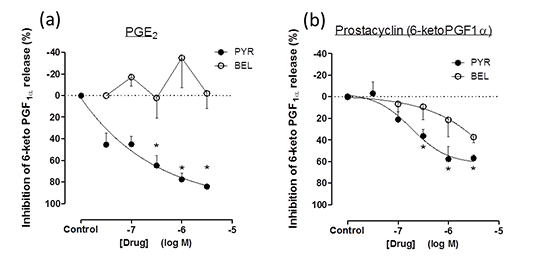Differential role of phospholipase A2 isoforms in release of prostacyclin and prostaglandin E2 from human endothelial cells Prostaglandins (PGs), which include prostacyclin and PGE2, are powerful hormones formed from arachidonic acid (AA) by the enzyme cyclo-oxygenase (COX) coupled with downstream synthase enzymes. AA is normally contained in membrane phospholipids but released when cells are activated by the actions of phospholipase A2 (PLA2) enzymes. PLA2 is expressed in a range of isoforms, which fall into three key families; iPLA2, cPLA2 and sPLA2. iPLA2s are calcium independent whilst cPLA2s and sPLA2s are activated by calcium. Endothelial cells are particularly enriched with COX and their release of PGs contributes to cardiovascular homeostasis. We have previously shown that prostacyclin release from endothelial cells lacking cPLA2 is greatly reduced (1), suggesting that this isoform is important in these cells. However others suggest that iPLA2 drives AA release in endothelial cells (2). In the current study, we have compared to effect of cPLA2, iPLA2 and sPLA2 on PG release by cultured endothelial cells. Methods: Blood outgrowth endothelial cells (BOEC) from healthy volunteers were isolated and cultured as described previously (3). Cells were plated on 96-well plates and stimulated with IL-1β (1ng/ml) for 24 hours before the addition of selective inhibitors of cPLA2 (pyrrophenone; PYR; 0.01-1μM), iPLA2 (bromoenol lactone; BEL; 0.1-3μM) or sPLA2 (YM26734; 1-30μM) or vehicle (0.1% DMSO) for 30mins. Cells were then stimulated for a further 30 minutes with thrombin (1U/ml; PBS) to activate PLA2 or with AA (50µM; ethanol 0.05% final), which provides substrate for PG formation directly. Prostacyclin (measured as its stable breakdown product 6-keto PGF1 α) and PGE2 were measured by ELISA. Results: Basal release (pg/ml) of PGE2 (203.4±60) and prostacyclin (365.2±61.9) were increased respectively by thrombin (815±95, 2296.0±362.3) and AA (1412.7±283.9, 3761.1±584.1), (p<0.05 one-way ANOVA followed by Dunnett's post-test). In thrombin stimulated cells, pyrrophenone (PYR) inhibited both prostacyclin and PGE2 release whilst bromoenol lactone (BEL) inhibited prostacyclin release only (Figure 1). YM26734 (30μM) had no effect on either PGE2 or prostacyclin release (p>0.05; t-test). None of the PLA2 inhibitors tested affected PG release from cells stimulated with AA (p>0.05; one-way ANOVA followed by Dunnet’s post-test).
Figure 1 : Effect of pyrophenone (PYR) or bromoenol lactone (BEL) on thrombin induced PGE2 (a) or prostacyclin (b) release from BOECs. Data is mean± S.E.M. for n=4 experiments. Data was analysed by one-way ANOVA followed by Dunnett’ s post-test. *p<0.05. Conclusions: These results suggest that AA release in endothelial cells is regulated by iPLA2 and cPLA2, but not sPLA2 and that intracellular compartmentalisation may link iPLA2 activity to prostacyclin release selectively versus PGE2 release. References: (1) Reed DM et al. 2014. pA2 online 111:186P; (2) Sharma J et al. (2010). Biochemistry 49: 5473-5481; (3) Starke RD et al. 2013. Blood 121: 2773-2784.
|


